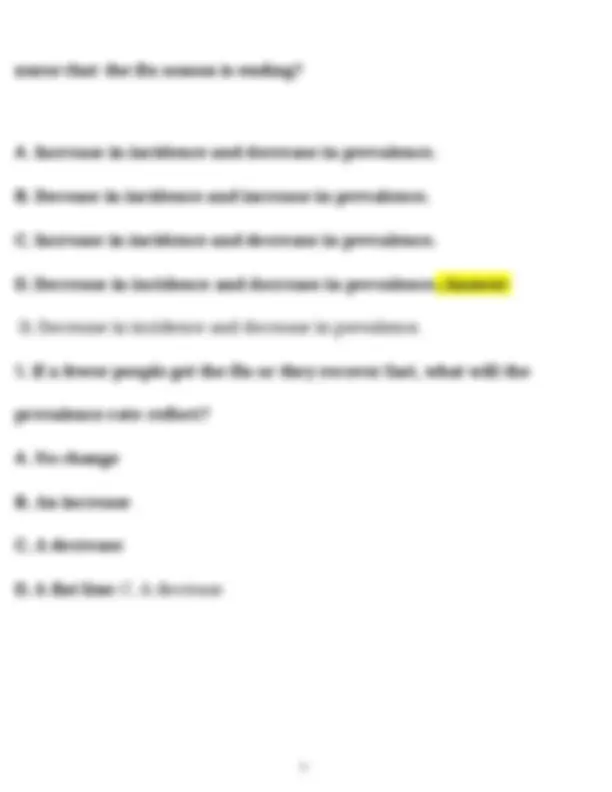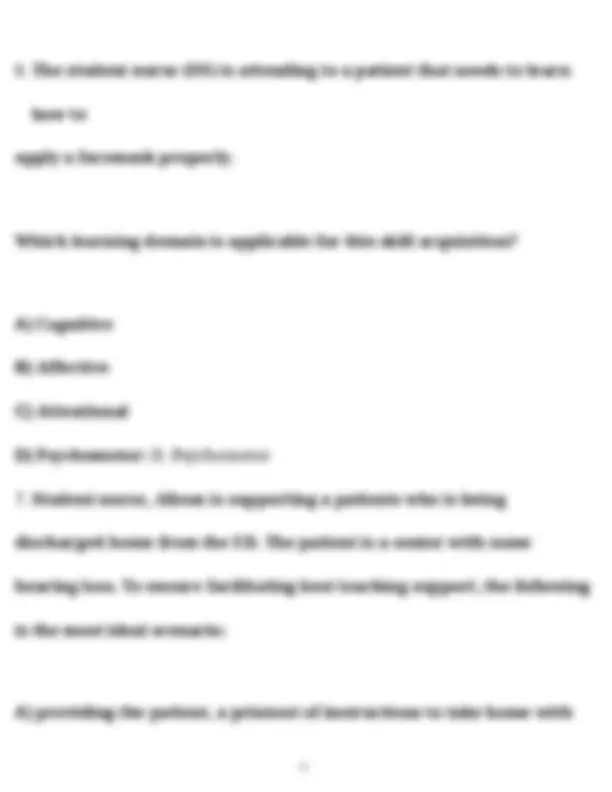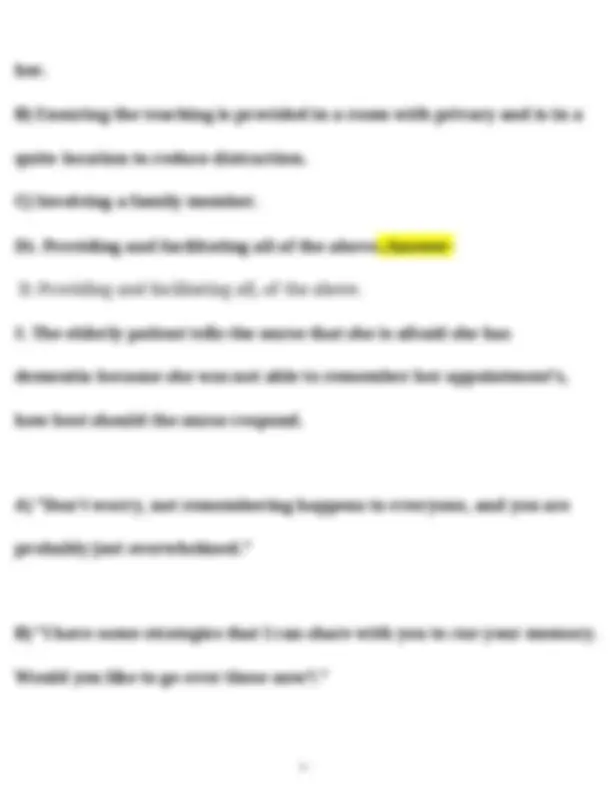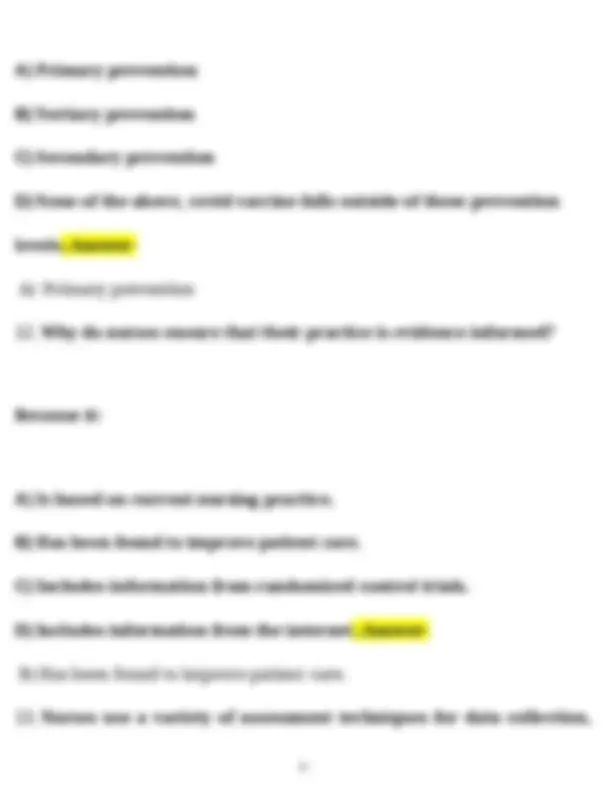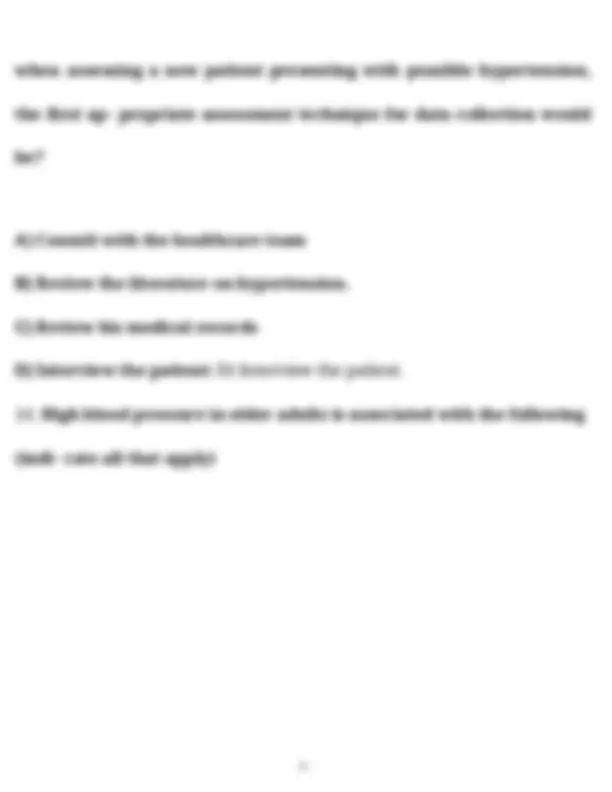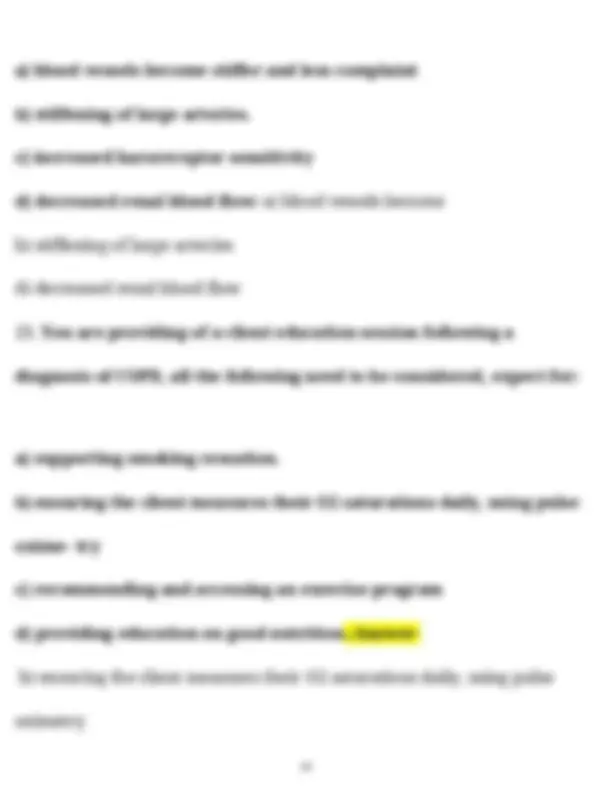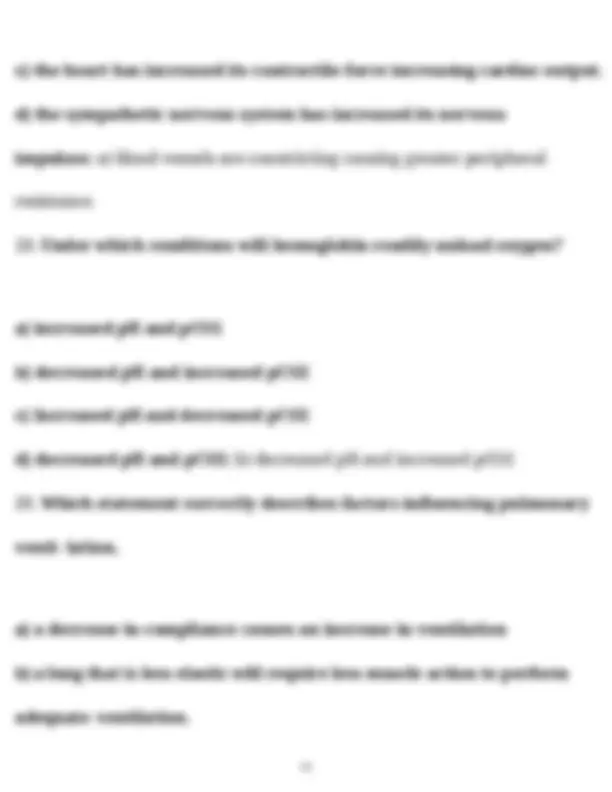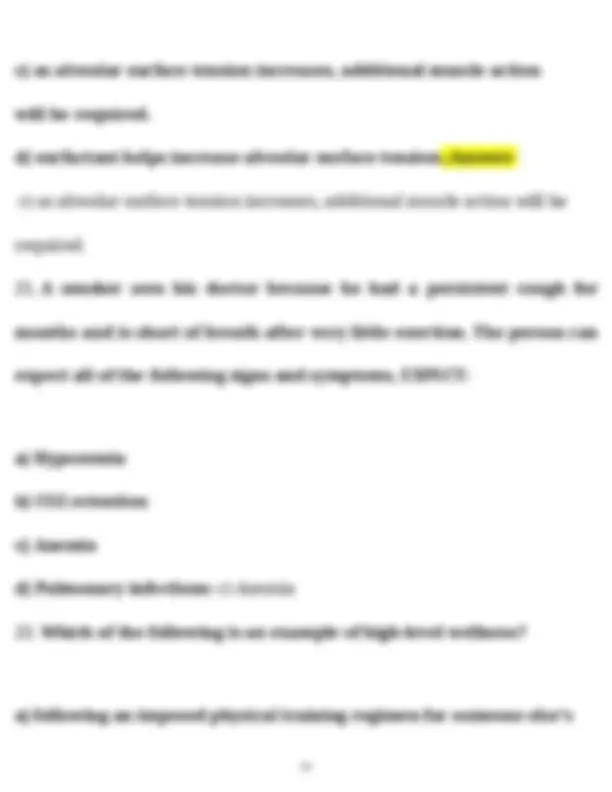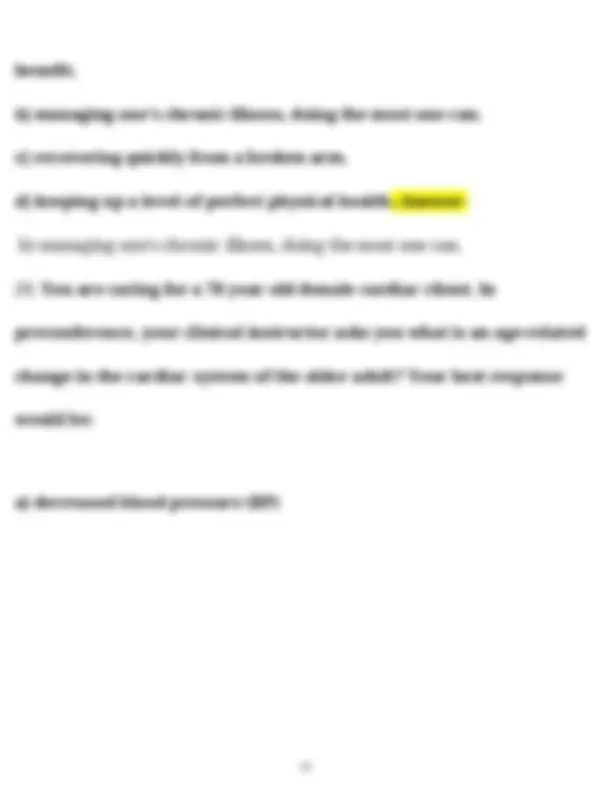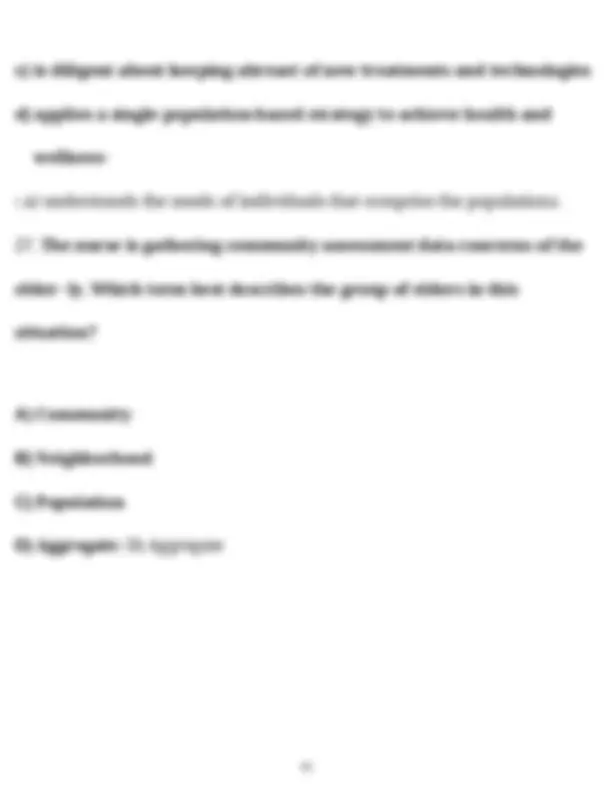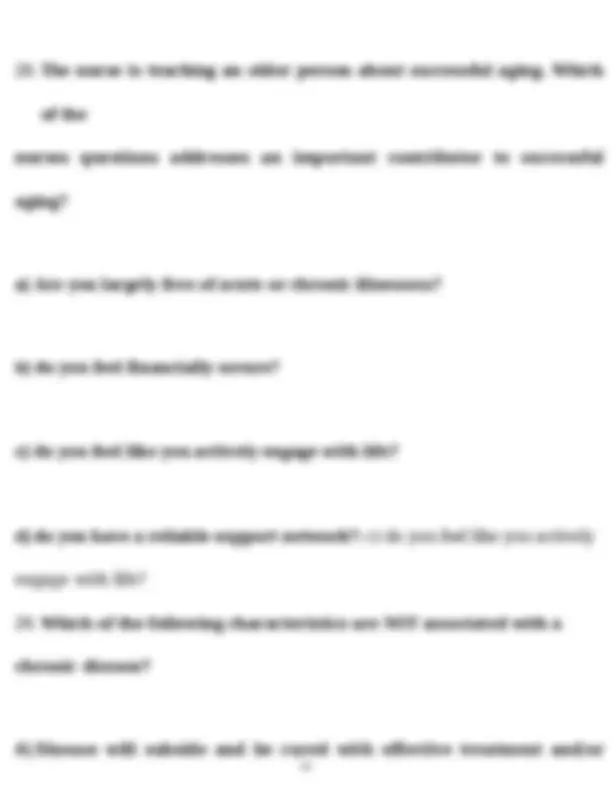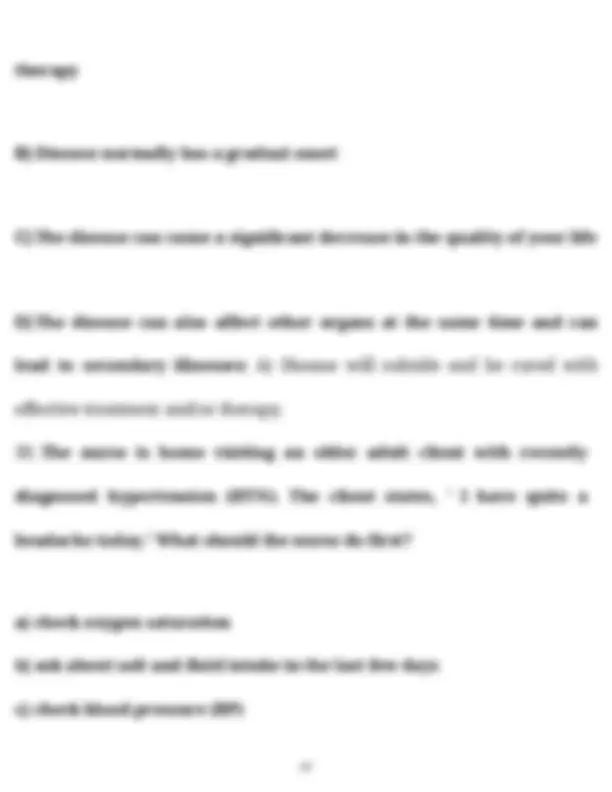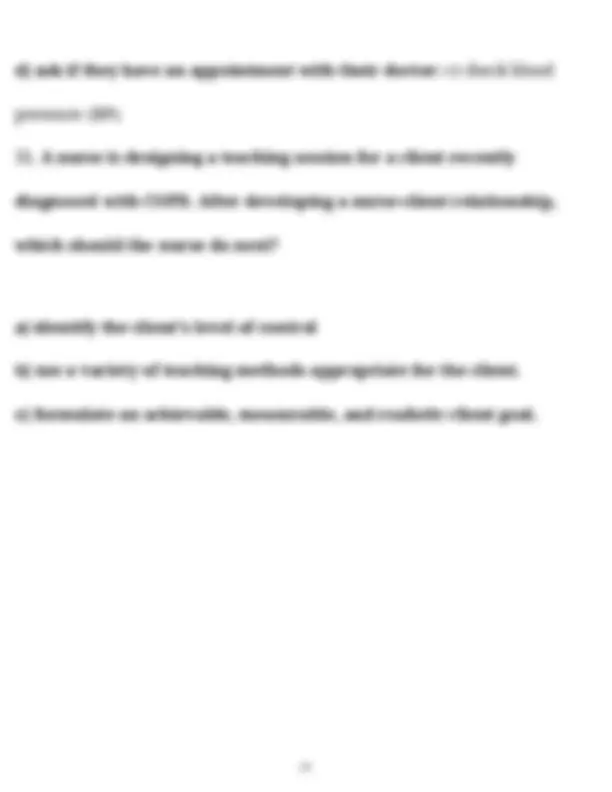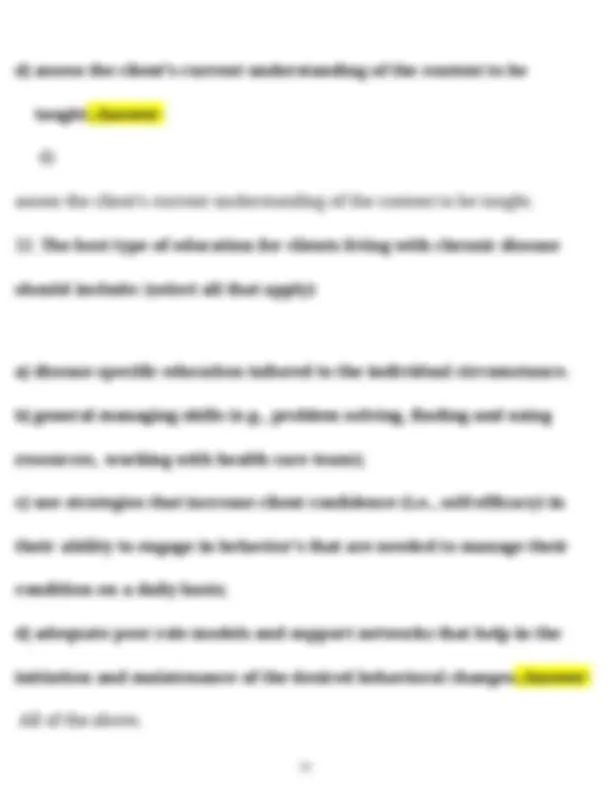Download BSNC 1000 midterm Questions With Complete Solutions, Exams of Nursing and more Exams Programming Languages in PDF only on Docsity!
1 / 8
BSNC 1000 Midterm Questions With Complete Solutions
- One of the basic concepts in epidemiology is the concept of risk. Risk refers to the: A. prevalence of an event occurring over a lifetime. B. probability that an event will occur within a specified time period. C. population most likely to develop a disease. D. rate of development of new cases.:Answer- A
- .A breast cancer screening program screened 8,000 females. They discovered 35 females previously been diagnosed with breast cancer and 20 females with no previous hx of breast cancer diagnosed as a result to the screening. The incidence proportion would reflect: A. a newly diagnosed cases of breast cancer in this population of females
2 / 8 B. current & past breast cancer events in this populations of females C. past breast cancer events in this population of females. D. the population of females who had no evidence of breast cancer.:Answer- A. a newly diagnosed cases of breast cancer in this population of females.
- A business executive develops symptoms of the flu 1 day after returning by air from a cross-Atlantic business trip that ran for 2 consecutive stressful 10-hour days. This individual's development of flu symptoms illustrates the relationship between: A. host and agent. B. host, agent, and environment. C. risk, and causality. D. morbidity, and disease.:Answer- B. host, agent, and environment.
- Which of the following statements would indicate to a community
4 / 8
- The student nurse (SN) is attending to a patient that needs to learn how to apply a facemask properly. Which learning domain is applicable for this skill acquisition? A) Cognitive B) Affective C) Attentional D) Psychomotor: D. Psychomotor
- Student nurse, Alison is supporting a patients who is being discharged home from the ED. The patient is a senior with some hearing loss. To ensure facilitating best teaching support, the following is the most ideal scenario: A) providing the patient, a printout of instructions to take home with
5 / 8 her. B) Ensuring the teaching is provided in a room with privacy and is in a quite location to reduce distraction. C) Involving a family member. D). Providing and facilitating all of the above.:Answer- D. Providing and facilitating all, of the above.
- The elderly patient tells the nurse that she is afraid she has dementia because she was not able to remember her appointment's, how best should the nurse respond. A) "Don't worry, not remembering happens to everyone, and you are probably just overwhelmed." B) "I have some strategies that I can share with you to cue your memory. Would you like to go over these now?."
7 / 8 B) Lack of secure housing C) Possible security issues D) Fewer chronic diseases: b) lack of secure housing & c) possible security issues
- You are considering best practice for infection control, to reduce risk of transmissions, which is the BEST strategy that you must adhere to? A) Adhering to appropriate hand hygiene and hand washing practices. B) Wearing a clean uniform. C) Maintaining social distancing between patients and families. D) Diagnosing possible infections in all presenting patients.:Answer- A) Adhering to appropriate hand hygiene hand washing practices.
- Covid 19 vaccine for an family living in the community, is which prevention level?
8 / 8 A) Primary prevention B) Tertiary prevention C) Secondary prevention D) None of the above, covid vaccine falls outside of these prevention levels.:Answer- A) Primary prevention
- Why do nurses ensure that their practice is evidence informed? Because it: A) Is based on current nursing practice. B) Has been found to improve patient care. C) Includes information from randomized control trials. D) Includes information from the internet.:Answer- B) Has been found to improve patient care.
- Nurses use a variety of assessment techniques for data collection,
10 / 8 a) blood vessels become stiffer and less complaint b) stiffening of large arteries. c) increased baroreceptor sensitivity d) decreased renal blood flow: a) blood vessels become b) stiffening of large arteries d) decreased renal blood flow
- You are providing of a client education session following a diagnosis of COPD, all the following need to be considered, expect for: a) supporting smoking cessation. b) ensuring the client measures their O2 saturations daily, using pulse oxime- try c) recommending and accessing an exercise program d) providing education on good nutrition.:Answer- b) ensuring the client measures their O2 saturations daily, using pulse oximetry
11 / 8
- A patient with essential hypertension might have pressures of 200/120 mm Hg.This hypertensive state could result in all of the following changes except: a) increased work of the left vernticle b) increased incidence of coronary artery disease. c) increased damage to blood vessel endothelium d) decreased size of the heart muscle.:Answer- d) decreased size of the heart muscle
- which of the following statement is TRUE about the influence on blood pressure: a) An increase in cardiac output corresponds to decrease in blood pressure (BP), due to the increased delivery. b) systemic vasodilation would increase blood pressure (BP), due to diversion of blood to essential areas.
13 / 8 c) the heart has increased its contractile force increasing cardiac output. d) the sympathetic nervous system has increased its nervous impulses: a) blood vessels are constricting causing greater peripheral resistance.
- Under which conditions will hemoglobin readily unload oxygen? a) increased pH and pCO b) decreased pH and increased pCO c) Increased pH and decreased pCO d) decreased pH and pCO2: b) decreased pH and increased pCO
- Which statement correctly describes factors influencing pulmonary venti- lation. a) a decrease in compliance causes an increase in ventilation b) a lung that is less elastic will require less muscle action to perform adequate ventilation.
14 / 8 c) as alveolar surface tension increases, additional muscle action will be required. d) surfactant helps increase alveolar surface tension.:Answer- c) as alveolar surface tension increases, additional muscle action will be required.
- A smoker sees his doctor because he had a persistent cough for months and is short of breath after very little exertion. The person can expect all of the following signs and symptoms, EXPECT: a) Hypoxemia b) CO2 retention c) Anemia d) Pulmonary infections: c) Anemia
- Which of the following is an example of high-level wellness? a) following an imposed physical training regimen for someone else's
16 / 8 b) increased ability to respond to stress c) decreased cardiac output d) thinning of blood vessel walls.:Answer- c) decreased cardiac output
- The nurse is setting up an education session with an 85-year-old patient who will be going home on anticoagulant therapy. Which strategy would reflect consideration of aging changes that may exist with this patient? A. Show a colorful video about anticoagulation therapy. B. Present all the information in one session just before discharge. C. Give the patient pamphlets about the medications to read at home. D. Develop large-print handouts that reflect the verbal information presented.- : d) develop large-print handouts reflecting the information presented
- Which of the following is the most accurate statement about the
17 / 8 determi- nants of health? a) If a pathogenic organism can be shown to cause a disease, no other determinants are relevant b) they reflect underlying forces that are at work in the subsequent develop- ments of disease. c) one determinant if operating to bring about each disease. d) each determinant can usually be traced to specific diseases: b) they reflect underlying forces that are at work in the subsequent development of disease.
- Which nurse will have the best understanding of the focus of population health nursing? The nurse who: a) Understands the needs of individuals that comprise the populations b) Focuses on the population as a whole rather than on individuals and families
19 / 8
- The nurse is teaching an older person about successful aging. Which of the nurses questions addresses an important contributor to successful aging? a) Are you largely free of acute or chronic illnessess? b) do you feel financially secure? c) do you feel like you actively engage with life? d) do you have a reliable support network?: c) do you feel like you actively engage with life?
- Which of the following characteristics are NOT associated with a chronic disease? A) Disease will subside and be cured with effective treatment and/or
20 / 8 therapy B) Disease normally has a gradual onset C) The disease can cause a significant decrease in the quality of your life D) The disease can also affect other organs at the same time and can lead to secondary illnesses: A) Disease will subside and be cured with effective treatment and/or therapy.
- The nurse is home visiting an older adult client with recently diagnosed hypertension (HTN). The client states, ' I have quite a headache today.' What should the nurse do first? a) check oxygen saturation b) ask about salt and fluid intake in the last few days c) check blood pressure (BP)

